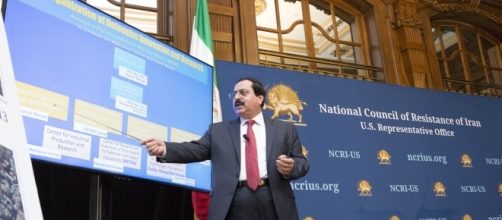A report outlining the newest intelligence released this week exposes seven sub-divisions which detail Iran’s nuclear enrichment and weaponization program. Full details were made public on Monday (21 May 2017) by the Deputy Director of the NCRI (National Council of Resistance of Iran) Washington office. Alireza Jafarzadeh (pictured) revealed the onsite secret mechanisms from sources affiliated with the MEK network, which has exposed the Iranian regime’s covert operation to continue it’s nuclear expansion capabilities.
On signing the Joint Comprehensive Plan of Action (JCPOA 5+1) ‘Nuclear Agreement’ in 2015 the regime had effectively agreed to dismantle its apparatus to disable plants capable of enriching Uranium; yet in Monday’s report seven subdivisions including a Center for Research and Expansion of Technologies on Explosion and Impact (METFAZ) are identified as being active.
Exposing Iran’s Nuclear Nerve Center
Under the auspices of a Defense Ministry’s SPND (Organization of Defensive Innovation and Research), the program is said to have nuclear weapons grade equipment, which is possible given that neither have any of the country's military sites have been accessible for monitoring or checking. For the last six months, the Islamic Revolutionary Guards Corps (IRGC) mandated by the country’s Supreme Leader to protect the regime’s power of ultimate authority, have been denying access to any regulatory monitoring bodies.
So, as safeguard to declare the Iran regime’s intentions in nuclear, the report recommends that in order to understand the scope of the regime’s activities, “it is critical that the IAEA (International Atomic Energy Agency) inspect and monitor not only the so-called ‘Research Academy’ project but also all other sites related to the SNPD.
”
The International Atomic Energy Agency’s position
Instead of sticking with the Nuclear Agreement to dismantle its Uranium enrichment apparatus, through deception of R&D the Iranian regime continues to refine its ballistic missile production capabilities. Furthermore, by claiming that military sites are out of scope for the IAEA’s investigation, inspection and monitoring, the regime has effectively created a protective shield for its nuclear weapon’s program.
This position has also soured the original good reasoning behind the Nuclear Agreement to ‘free up financial assets and lift trade sanctions’ signed by Iran and the United Nations Security Council countries (China, France, Russian, United Kingdom, United States) plus Germany.
So much so, that counter to sweetening-up the regime to play ball and encourage a more open Iran in terms of dialogue; instead of thwarting its nuclear weaponization capabilities the deal only seems to have emboldened its nuclear desires to a level of paranoia of being part of the free world.
The Iranian regime must comply
The insipid nature of the regime has been called-out many times by Mrs. Maryam Rajavi in her role as President-elect of the main Iranian resistance coalition group NCRI. Targeting the regime as ‘illegitimate’ in the eyes of an Iranian electorate, the NCRI continues to campaign in exile for democratic and fair elections, a secular state, workers’ and minority rights and for a non-nuclear Iran.
The report concludes that the international community needs to end the country's enrichment and weaponization program as a top priority, allowing the IAEA complete access to all sites with nuclear material to assure its compliance with the global NTP (Nuclear Non-Proliferation) Treaty.

